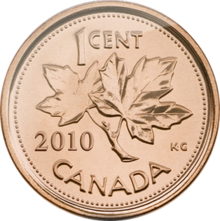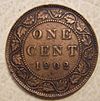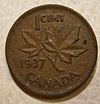
The United States Mint is a bureau of the Department of the Treasury responsible for producing coinage for the United States to conduct its trade and commerce, as well as controlling the movement of bullion. The U.S. Mint is one of two U.S. agencies that manufactures physical money. The other is the Bureau of Engraving and Printing, which prints paper currency. The first United States Mint was created in Philadelphia in 1792, and soon joined by other centers, whose coins were identified by their own mint marks. There are currently four active coin-producing mints: Philadelphia, Denver, San Francisco, and West Point.

The Royal Canadian Mint is the mint of Canada and a Crown corporation, operating under the Royal Canadian Mint Act. The shares of the Mint are held in trust for the Crown in right of Canada.

In Canada, a dime is a coin worth ten cents. It has been the physically smallest Canadian coin since 1922; it is smaller even than the country's penny, despite its higher face value. According to the Royal Canadian Mint, the official national term of the coin is the 10-cent piece, but in practice, the term dime predominates in English-speaking Canada. It is nearly identical in size to the American dime. Unlike its American counterpart, the Canadian dime is magnetic due to a distinct metal composition. From 1968 to 2000, it was composed entirely of nickel, and since 2001, it has consisted of a steel core with plating composed of layers of nickel and copper.

The quarter, short for quarter dollar, is a Canadian coin worth 25 cents or one-fourth of a Canadian dollar. It is a small, circular coin of silver colour. According to the Royal Canadian Mint, the official name for the coin is the 25-cent piece, but in practice it is usually called a "quarter", much like its American counterpart. In Canadian French, it is called a caribou. The coin is produced at the mint's facility in Winnipeg, Manitoba.

The Canadian fifty-cent coin is a Canadian coin worth 50 cents. The coin's reverse depicts the coat of arms of Canada. At the opening ceremonies for the Ottawa branch of the Royal Mint, held on January 2, 1908, Governor General Earl Grey struck the Dominion of Canada's first domestically produced coin. It was a silver fifty-cent coin bearing the effigy of King Edward VII.
The Hong Kong coinage, including 10¢, 20¢, 50¢, $1, $2, $5 & $10, is issued by Hong Kong Monetary Authority on behalf of the Government of Hong Kong. From 1863 until 1992, these coins were embossed with the reigning British monarch's effigy. Since 1 January 1993, a new series depicting the bauhinia flower was gradually issued, including a new denomination of $10. Since the beginning of the coin replacement programme on 1 January 1993, over 585 million coins featuring Queen Elizabeth II have been withdrawn from circulation. However, these coins remain legal tender. The total value of coins in circulation in Hong Kong can be found in Monthly Statistical Bulletin and the Annual Report.
The British farthing was a British coin worth a quarter of an old penny. It ceased to be struck after 1956 and was demonetised from 1 January 1961.

The United States large cent was a coin with a face value of 1/100 of a United States dollar. Its nominal diameter was 11⁄8 inch (28.57 mm). The first official mintage of the large cent was in 1793, and its production continued until 1857, when it was officially replaced by the modern-size one-cent coin.
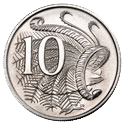
The Australian ten-cent coin is a coin of the decimal Australian dollar. When the dollar was introduced as half of an Australian pound on 14 February 1966, the coin inherited the specifications of the pre-decimal shilling; both coins were worth one twentieth of a pound and were called "bob". On introduction it was the fourth-lowest denomination coin. Since the withdrawal from circulation of the one and two cent coins in 1992, it has been the second-lowest denomination coin in circulation.
The coins of Canada are produced by the Royal Canadian Mint and denominated in Canadian dollars ($) and the subunit of dollars, cents (¢). An effigy of the reigning monarch always appears on the obverse of all coins. There are standard images which appear on the reverse, but there are also commemorative and numismatic issues with different images on the reverse.
One of the most profitable aspects of the Royal Canadian Mint (RCM) is its numismatic product line. The first numismatic coin from the RCM was arguably the 1935 dollar commemorating the Silver Jubilee of King George V. Though intended for circulation, it was the first Canadian coin commemorating an event. The decision to issue this coin was made in October 1934 by Prime Minister R. B. Bennett. There were economic and patriotic motivations for the release of a silver dollar, including a hope to boost the silver mining industry. In future years, the silver dollar would have a more emotional meaning for many Canadians because it was also the first coin to have the Voyageur motif on its reverse.
The coins of the Australian dollar were introduced on 14 February 1966, although they did not at that time include the one-dollar or two-dollar coins. The dollar was equivalent in value to 10 shillings in the former currency.
The Canadian silver dollar was first issued by the Royal Canadian Mint in 1935 to commemorate the Silver Jubilee of King George V. The coin's reverse design was sculpted by Emanuel Hahn and portrays a voyageur and a person of Indigenous descent paddling a birch-bark canoe. The faint lines in the background represent the Northern Lights. The voyageur design was used on the dollar until 1986. It was then replaced with the 1987 Canadian 1-dollar coin. 1967 marked the end of the silver dollar as a business strike, or a coin issued for circulation. After 1967, the dollar coin was made of nickel, except for non-circulating commemorative issues for the collector market, which continue to contain silver.

The Australian pre-decimal halfpenny coin, commonly known as a ha’penny, was the smallest denomination of the Australian Pound in circulation. It was a unit of currency that equalled half of a penny, 1/24 of a shilling, or 1/480 of a pound. The coin was made to be equivalent to the British halfpenny; its dimensions, composition and values were equivalent, and additionally, the two currencies were fixed at par.
One of the most highly profitable aspects of the Royal Canadian Mint's enterprise is in its Numismatic product line. The euphoria surrounding the year 2000 led to the birth of the Millennium 25-cent coin program. The numismatic line included proof quality coins sold individually or as a complete set. This level of excess would come to signify the coming decade. The number of numismatic releases would increase on an annual basis starting in 2003. Numismatic three cents, five cents, and ten cents would be introduced, along with numismatic three dollars and eight dollars. Luxury coins would not be immune to the dramatic increases that ensued. Coins with face values of 250, 300 and 350 dollars would be introduced by 2006.
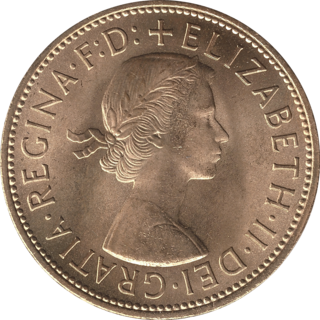
The British pre-decimal penny was a denomination of sterling coinage worth 1⁄240 of one pound or 1⁄12 of one shilling. Its symbol was d, from the Roman denarius. It was a continuation of the earlier English penny, and in Scotland it had the same monetary value as one pre-1707 Scottish shilling. The penny was originally minted in silver, but from the late 18th century it was minted in copper, and then after 1860 in bronze.

The 100 yen coin is a denomination of Japanese yen. These coins were first minted in 1957 using a silver alloy, before the current design was adopted with an alloy change in 1967. It is the second-highest denomination coin in Japan, after the 500 yen coin. The current 100 yen coin is one of two denominations that depict the emperor's rule date in Arabic numerals rather than kanji.

The double sovereign is a gold coin of the United Kingdom with a face value of two pounds sterling (£2). Rarely issued in the first 150 years after its debut in 1820, it never had a significant presence in circulation. It became a collector and bullion coin, and has been struck most years since 1980. It features the reigning monarch on its obverse and, most often, Benedetto Pistrucci's depiction of Saint George and the Dragon on the reverse.

The 1909-S VDB Lincoln Cent is a low-mintage coin of the United States dollar. It is a key date variety of the one-cent coin produced by the United States Mint in San Francisco in 1909. The Lincoln penny replaced the Indian Head penny and was the first everyday U.S. coin to feature an actual person, but it was immediately met with controversy over the inclusion of the initials of the sculptor who designed the coin, Victor David Brenner, on the reverse.

The Jubilee coinage or Jubilee head coinage are British coins with an obverse featuring a depiction of Queen Victoria by Joseph Edgar Boehm. The design was placed on the silver and gold circulating coinage beginning in 1887, and on the Maundy coinage beginning in 1888. The depiction of Victoria wearing a crown that was seen as too small was widely mocked, and was replaced in 1893. The series saw the entire issuance of the double florin (1887–1890) and, in 1888, the last issue for circulation of the groat, or fourpence piece, although it was intended for use in British Guiana. No bronze coins were struck with the Jubilee design.

